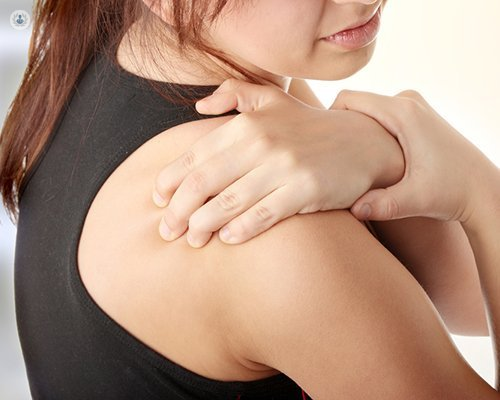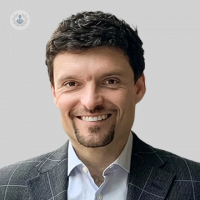Rehabilitation following reverse polarity arthroplasty
Written in association with:Revered consultant shoulder and elbow orthopaedic surgeon Mr Paolo Consigliere discusses the rehabilitation regime that he encourages after reverse polarity arthroplasty.

How has reverse total shoulder arthroplasty (RTSA) helped shoulder arthroplasty, patients?
The introduction of reverse total shoulder arthroplasty (RTSA) in the 1980s marked a pivotal advancement in shoulder arthroplasty, particularly benefiting patients with rotator cuff-deficient shoulders. Developed by Dr Paul Grammont, RTSA redefined shoulder joint biomechanics, enabling the deltoid muscle to compensate for the deficient rotator cuff. Rehabilitation protocols for RTSA were adapted to suit the unique mechanics of the reverse prosthesis, focusing on deltoid strengthening and scapular stabilisation exercises.
In recent decades, shoulder arthroplasty rehabilitation protocols have continued to progress, incorporating evidence-based practices and tailored approaches. Contemporary rehabilitation now follows a comprehensive, phased methodology that includes pain management, range of motion exercises, strengthening, and functional training. Additionally, advances in imaging technology, surgical techniques, and prosthetic design have further refined these rehabilitation strategies, contributing to enhanced outcomes and greater patient satisfaction.
What happens after surgery?
After surgery, a period of immobilisation typically follows. Standard rehabilitation protocols generally involve placing the arm in a sling for 3 to 6 weeks before allowing movement of the operated shoulder. Although this approach is considered safe, it can delay the patient’s return to normal function, significantly affecting independence and quality of life. I participated in a study with several colleagues which found that delayed rehabilitation with prolonged sling use can negatively impact patients’ balance, increasing the risk of falls and fractures.
In my practice, I use an accelerated rehabilitation protocol, where the sling is worn only for comfort during the initial days following surgery, with a maximum duration of one week. From the first day, patients are encouraged to mobilise the shoulder as tolerated by their pain level.
In the aforementioned study, patients following this accelerated approach showed no immediate complications, indicating its safety. Additionally, these patients experienced fewer falls than those immobilised for 3 to 6 weeks, suggesting that early mobilisation improves balance and stability.
Here is my rehabilitation regime for reverse total shoulder arthroplasty surgery:
Phases of Rehabilitation
1. Immediate postoperative phase (Weeks 0-2)
In the immediate postoperative phase, spanning from weeks 0 to 2, the primary goals are to protect the surgical repair, manage pain and inflammation, and maintain mobility in the elbow, wrist, and hand. During this period, it is recommended to wear a shoulder immobiliser or sling for the first week to enhance comfort.
Passive range of motion (PROM) exercises should be performed for the shoulder, emphasising gentle flexion, abduction, and external rotation, while active range of motion (AROM) exercises are encouraged for the elbow, wrist, and hand.
Gentle pendulum exercises can also be introduced to promote shoulder mobility. To avoid undue strain on the surgical repair, shoulder extension past neutral and combined adduction with internal rotation should be avoided.
2. Early rehabilitation phase (Weeks 2-8)
During this phase, the primary goals are to gradually restore shoulder mobility, begin improving shoulder strength, and continue with pain management. Activities include progressing to active-assisted range of motion (AAROM) and active range of motion (AROM) exercises, alongside gentle isometric strengthening exercises.
Passive range of motion (PROM) exercises can be continued as needed, and scapular stabilisation exercises are introduced to support shoulder stability. To protect the healing shoulder, it is important to avoid lifting, pushing, or pulling heavy objects.
3. Intermediate rehabilitation phase (Weeks 8-16)
The focus during this phase is on enhancing shoulder strength and endurance while improving functional range of motion. Activities include advancing to isotonic strengthening exercises targeting the shoulder muscles, and increasing both the intensity and complexity of scapular stabilisation exercises. Light functional activities and exercises that mimic daily tasks are also introduced, with a gradual increase in the use of the operated arm for activities of daily living (ADLs).
4. Advanced rehabilitation phase (Weeks 16-24)
In this phase, the focus shifts towards achieving near-normal strength and function, as well as enhancing dynamic shoulder stability. Activities involve continuing with progressive resistance exercises and, if appropriate, incorporating plyometric and sport-specific exercises.
Proprioception and neuromuscular control drills are emphasised to improve coordination and stability. Additionally, a gradual return to work or recreational activities is encouraged, with appropriate modifications to ensure safety and support the healing process.
5. Return to activity phase (6+ Months)
The final phase focuses on a return to full functional and recreational activities while maintaining strength and flexibility gains. This includes ongoing strengthening and conditioning exercises, as well as a gradual return to more demanding activities, ensuring proper mechanics and performing them without pain. Regular follow-ups with the healthcare team are recommended to monitor progress and adjust the rehabilitation programme as needed for optimal recovery.
Effective rehabilitation following reverse polarity shoulder arthroplasty requires a systematic and progressive strategy aimed at restoring function, strength, and mobility while minimising complications. For optimal recovery, it is crucial to maintain a close partnership among the patient, orthopedic surgeon, and physical therapist.
If you would like to book a consultation with Mr Consigliere, do not hesitate to do so by visiting his Top Doctors profile today.
Sources
(Lee J, Consigliere P, Fawzy E, Mariani L, Witney-Lagen C, Natera L, Buch B, Atoun E, Sforza G, Amar E, Levy O. Accelerated rehabilitation following reverse total shoulder arthroplasty. J Shoulder Elbow Surg. 2021 Sep;30(9). doi: 10.1016/j.jse.2020.11.017. Epub 2021 Jan 5. PMID: 33418090)


